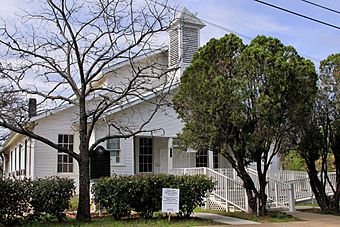Clarksville Historic District (Austin, Texas) facts for kids
Quick facts for kids |
|
|
Clarksville Historic District
|
|

The Sweet Home Baptist Church serves as the focal point of the neighborhood.
|
|
| Location | Bounded by W. Lynn, Waterston, W. 10th and MO-PAC Expwy., Austin, Texas |
|---|---|
| Area | 305 acres |
| Built | 1871 |
| Architect | Edmerson, Willis |
| Architectural style | American Craftsman Bungalow, Late Victorian |
| NRHP reference No. | 76002070 |
| Added to NRHP | December 1, 1976 |
The Clarksville Historic District is a special area in Austin, Texas. It is located west of downtown Austin, close to Lady Bird Lake. This district is known for its many historic homes and buildings. While it's part of the larger Old West Austin Historic District, Clarksville has its own unique story. It is different from nearby neighborhoods like Old Enfield and Tarrytown.
Clarksville was founded in 1871 by a man named Charles Clark. He was a freedman, meaning he was a person who had been enslaved but was now free. This makes Clarksville the oldest surviving "freedman's town" west of the Mississippi River. These towns were created by former African-American slaves after the American Civil War. In 1976, the Clarksville Historic District was added to the National Register of Historic Places. This recognized its important and special history.
Contents
History of Clarksville
The land where Clarksville now stands was once part of a large property. This property belonged to Texas Governor Elisha Pease. In 1871, Governor Pease sold about 365 acres to Charles Clark. Clark then built his own house on what is now West Tenth Street. He also divided the rest of the land into smaller plots. These plots were sold to other freedmen, helping them build new lives.
Clarksville quickly became part of Austin, even though it was a mile west of the city. This was especially true when the International-Great Northern Railroad built tracks nearby in the 1870s. The Sweet Home Baptist Church was founded before 1882. It remains a very important part of the community today. A school also existed in Clarksville as early as the 1890s.
Early Freedman's Towns
Clarksville was one of at least six communities founded by formerly enslaved people around Austin. Other towns included Wheatville, started by James Wheat. Wheatville was also home to a respected Black leader, Reverend Jacob Fontaine. Pleasant Hill was another such community.
Challenges and Changes
In the early 1900s, developers realized Clarksville's land was valuable. It was close to the growing downtown Austin area. At that time, Austin city leaders wanted to have most Black residents live in the eastern part of the city. They put pressure on Black communities in west Austin, like Clarksville and Wheatville, to move.
In 1918, the Austin school board closed the Clarksville school. Later, residents were forced to use city services only in east Austin, or go without them. The 1928 Austin city plan supported these ideas. It suggested providing services in east Austin to encourage Black residents to move there. However, most Clarksville residents chose to stay. They endured the lack of services to keep their community.
In 1968, Clarksville residents protested a plan to build a highway. This highway would run along the Missouri Pacific Railroad, on the western edge of Clarksville. Their protest was not successful. The completed Mopac Expressway cut through the community. This forced 33 families to leave their homes.
Fighting for Preservation
Despite pressure to move to east Austin, Clarksville kept its strong African-American identity. In 1964, residents started asking Austin for money to improve and preserve their neighborhood. But dirt streets remained until 1975. A creek carrying unclean water also flooded homes from time to time.
However, things began to change in 1975. The Texas Historical Commission named a two-block-wide section of Clarksville a historic district. After this, the city paved the streets with asphalt. In 1976, the Austin City Council approved $100,000 to permanently pave streets. This money also helped improve drainage and expand the neighborhood playground. Another $100,000 was set aside to fix up homes.
That same year, Clarksville residents and their supporters won a big victory. They stopped a plan to build a major road through their community. This road would have connected Interstate 35 and the MoPac Expressway. Later in the 1970s, land values started to rise. This made it harder for lower-income residents to afford to live there. So, the Clarksville Community Development Corporation was created. Its goal was to provide affordable housing options. This helped keep the community's unique character. The district was officially added to the National Register of Historic Places in 1976.
Clarksville Today
Over the early 1900s, many European immigrants also settled in Clarksville. They helped build the diverse community that exists today. For example, Anthony Colanetta opened Anthony's Laundry & Cleaners in 1950. It was located at the corner of West 12th Street and West Lynn. Colanetta also built a drugstore and leased it to his friend Hylton Nau. The Nau Enfield Drugstore had a popular soda fountain, which closed in 2023.
In 1979, Craig Weller and Mark Skiles opened Clarksville Natural Grocery. A year later, they teamed up with John Mackey. Together, they opened the very first Whole Foods store. It was originally called Clarksville Natural Grocery.

